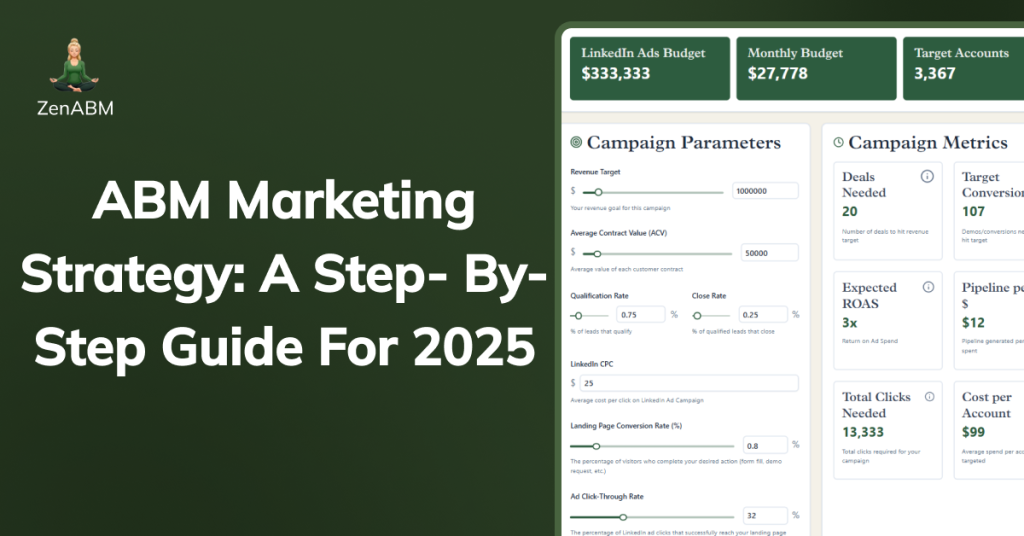Userpilot’s ABM marketing strategy absolutely crushed it.
They generated over $900,000 in pipeline at an ROI of $8 in pipeline per $1 spent, and ZenABM was born in the process 🙂
I’ll walk you through every tactical detail of their full-funnel ABM marketing strategy, the lessons learnt from their mistakes, plus some insider tips from ABM experts.
One more thing: This isn’t a surface-level overview. You’ll get a deep-dive playbook. I have tried my best to not leave “figure it out yourself” moments in the guide, unlike here:
A Step-by-Step ABM Marketing Strategy Guide for 2025: Snapshot
Userpilot’s ABM campaign pulled in $900K in pipeline, delivering $8 pipeline per $1 spent.
Their playbook:
- Build a Surgical Target Account List (TAL):
- Pin down your ICP (industry, size, tech stack).
- Size your list and budget by reverse-engineering revenue targets.
- Segment & Tier Your Accounts:
- Create dynamic tiers (one-to-many, persona-based clusters).
- Customize ads to each segment for higher engagement.
- Scale Personalization:
- Run multiple messaging experiments at once.
- Leverage ZenABM intent data for pinpoint outreach.
- Run a Full-Funnel Campaign:
- Align marketing + sales from awareness through close.
- Use clear stages: Identified → Aware → Interested → Considering → Selecting.
- Monitor & Optimize in Real Time:
- Track engagement via ZenABM dashboards.
- Pivot quickly based on account behavior.
- Measure & Attribute Rigorously:
- Connect pipeline directly to ad touches with ZenABM.
- Iterate continuously using data-driven insights.
Tech Stack: HubSpot, SalesLoft/Apollo, Clay, BuiltWith, Notion, and ZenABM (~$2.5K/mo).
In essence, Userpilot combined laser-focused targeting, dynamic segmentation, hyper-personalized messaging, and robust analytics via ZenABM to achieve stellar ROI.
Step #1: Define Your ICP & TAL + Budget Estimation
Any winning ABM marketing strategy starts with pinpointing exactly who to target.
First, craft your Ideal Customer Profile (ICP) based on firmographic and technographic signals:
- Industry
- Company size
- Geography
- Tech stack
- Must-have criteria (e.g., complementary tools)
“Data over gut” is the mantra—analyze top customers for common traits. Advanced teams even deploy AI to spot lookalikes automatically.
Pro Tip: Build your TAL in lockstep with Sales because ABM only works when both teams agree from day one. Remember: “Your list is your strategy.”
How Big Should Your TAL Be?
For a pilot, aim for a few hundred accounts, not thousands. Or reverse-engineer from revenue goals:
Define Your Goal
“We need $2M in ABM-sourced closed-won this fiscal year.”
Know Your Numbers
- Average Deal Size: $50K
- Close Rate: 25%
Calculate Opportunities
Opportunities = Revenue Goal ÷ (ADS × Close Rate)
= $2,000,000 ÷ ($50,000 × 0.25)
= 160
Funnel Mapping
| Stage* | Conversion* | Formula | Accounts Needed |
|---|---|---|---|
| Target → Engaged | 10% | 160 ÷ 0.10 | 1,600 |
| Engaged → Opportunity | 20% | 160 ÷ 0.20 | 800 |
| Opportunity → Closed-Won | 25% | — | 160 |
*Adjust stages, names, and rates to match your data. Even rough internal figures beat guesswork.
Budget Back into Accounts
Assume $70 CPEA on LinkedIn:
Budget = 1,600 × $70 ≈ $112K
Reality-Check & Iterate
- If 1,600 feels unwieldy, refine your ICP or lift conversions with sharper personalization.
- If budget overshoots, optimize mid-funnel conversion instead of broadening reach.
- Re-run quarterly as you collect fresh data.
Quick-Fill Template
- Revenue goal = $______
- Average deal size = $______
- Close rate = ____%
- Opportunities needed = …
- Target→Eng conversion = ____%
- Eng→Opp conversion = ____%
- TAL size = …
- Cost per engaged = $______
- Budget = …
Free Tool: Use the ABM Budget Calculator for deeper modeling.
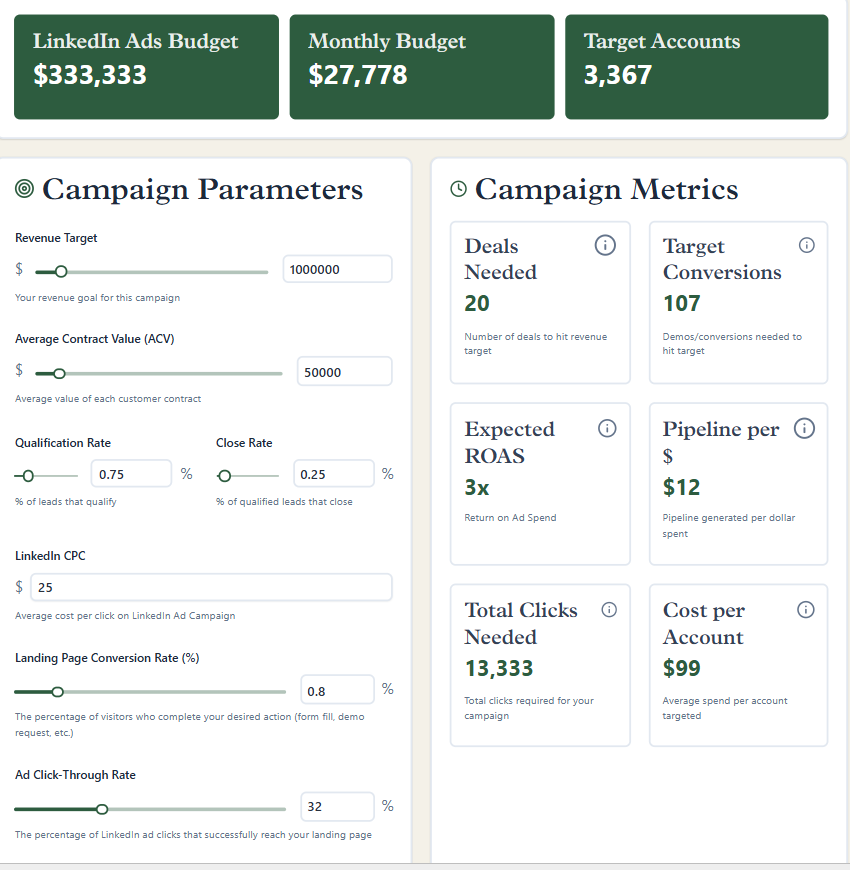
Userpilot’s TAL-Building Process
They kicked off by repurposing their H1 cold-outbound list, filtering for growth & enterprise “loss” accounts, then enriching via Clay + BuiltWith APIs, and stripping out any already-converted logos.
They even mined HubSpot lost-deal data for competitor “loss” accounts, then layered in persona enrichment via Apollo/Clay.
Bottom line: your TAL is the backbone of your ABM marketing strategy.
Step #2: Segment & Tier for Maximum Impact
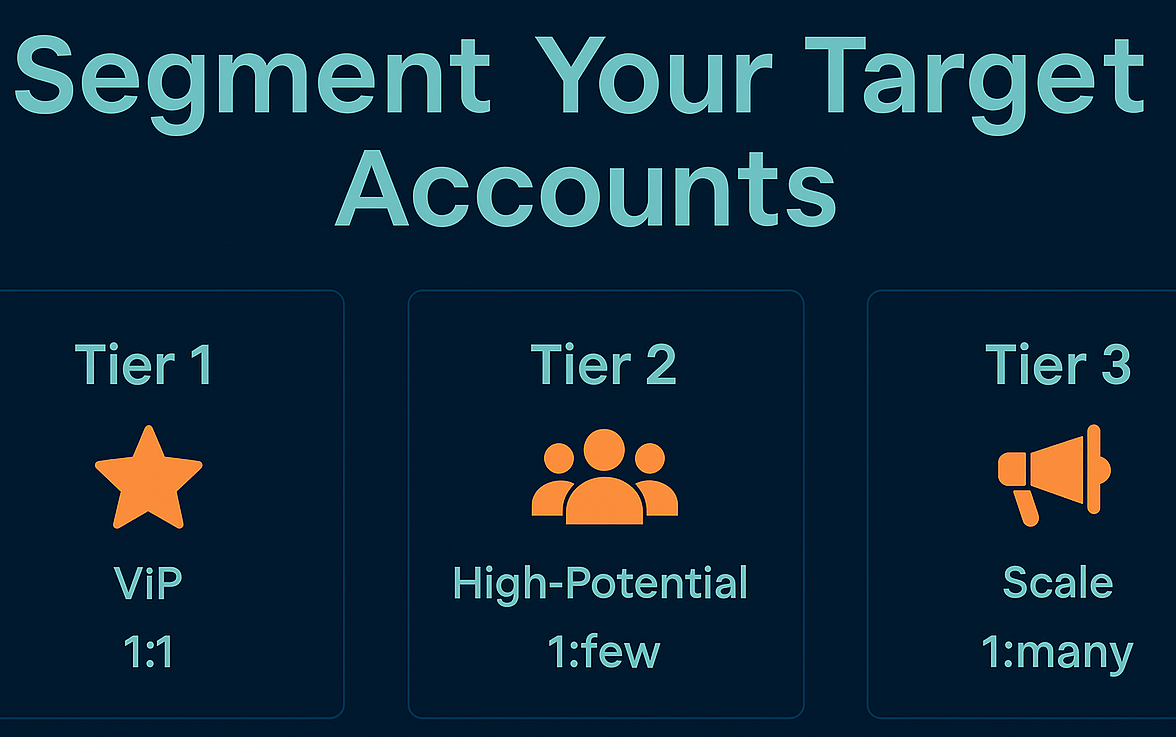
Not all accounts are created equal.
So, break your TAL into tiers to laser-focus your tactics:
- Tier 1 – VIP: Dream logos (Fortune 500, 10x ACV). One-to-one, white-glove campaigns. Ultra-personalized outreach.
- Tier 2 – Clusters: Groups of high-potential accounts. One-to-few approach. Industry or use-case–specific messaging.
- Tier 3 – Scaled: Broader, one-to-many campaigns to cast a wide net and identify which accounts show intent.
Userpilot ran one-to-many LinkedIn ads segmented by persona (8 segments), then used engagement data to trigger mid-funnel creative for “Interested” accounts.
Key takeaway: segment early, segment often (even at scale).
Step #3: Craft Messaging That Hits Home
Generic value props won’t cut it in an ABM marketing strategy. You need urgency-driving, pain-point–specific messages for each segment.
- Industry angle: “Struggling with [X] in Finance? Here’s how [solution] fixes it…”
- Role angle: “CMOs at {Industry} firms are cutting churn by 20%—here’s their blueprint.”
- Competitive angle: “How {Account} can outpace {Competitor}—a step-by-step guide.”
Userpilot tested multiple angles in parallel, then funneled the winning message into sales outreach, triggering BDR emails that referenced the exact ad topic the account clicked.
Pro Tip: Use dynamic tokens (e.g., industry names) in LinkedIn ad copy and automated email templates. Leverage ZenABM’s intent tags: campaign-level engagement and buyer intent pushed straight into your CRM:

Step #4: Design Your Full-Funnel Campaign (Align Marketing + Sales)
Map every touch from awareness through pipeline close because ABM is about orchestrating ads + sales outreach, not just one or the other.
Define Objectives & KPIs
Examples: 5 demos from Fortune 100, $1M pipeline in a quarter. Track engagement, opportunities created, pipeline, and revenue, not just MQL counts.
Co-Plan with Sales
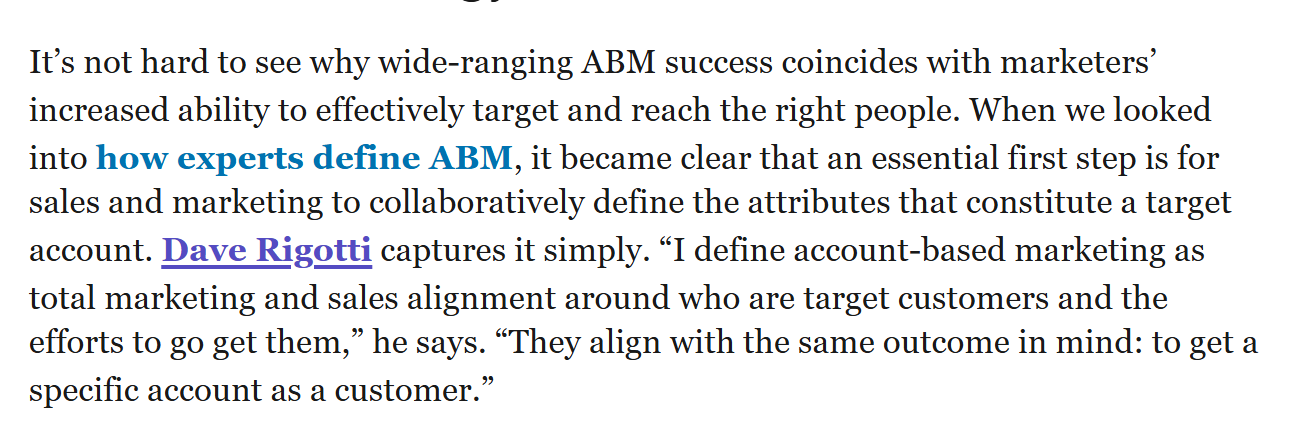
Involve BDRs/AEs from day one. Co-create cadences for when accounts hit engagement thresholds.
Pick Channels & Tactics
Userpilot leaned on LinkedIn Ads for precise targeting, spending ~$47K in Q1. Complement with targeted display and direct outreach (emails, calls, InMails) triggered by ad engagement.
Don’t trust other channels like DANs, especially for an ABM debut:
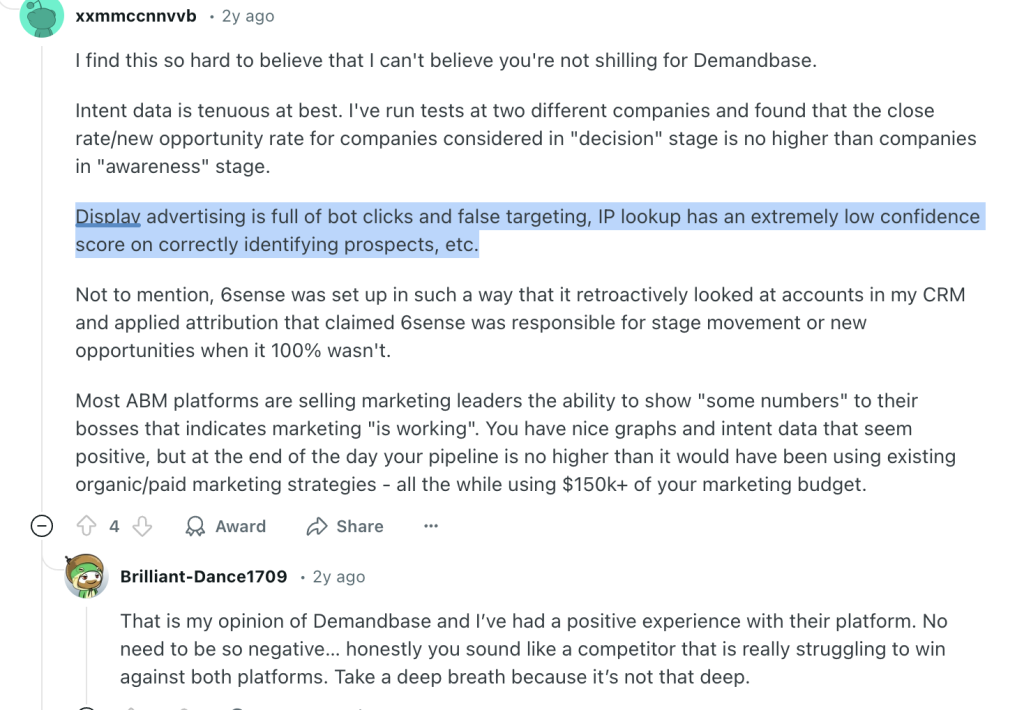
ABM Stages Framework
Here’s the framework they used at Userpilot:
- Identified: All targeted accounts
- Aware: ≥50 ad impressions
- Interested: ≥5 clicks or 10 engagements
- Considering: Demo/trial booked
- Selecting: Open deal
- Customer: Closed-won
Each stage triggers specific content (ads), and accounts hitting “Interested” get assigned to BDRs automatically.
Real-World Lesson & ZenABM’s Origin Story
“We overcomplicated scoring with page visits & weighted intent signals, only to find IP deanonymization identified just one company (ours!). After 300 visits over 90 days, Breeze Intelligence (Clearbit) flagged only us!
We simplified: only use quantitative LinkedIn ad engagement for scoring, and leverage qualitative intent (which ad they clicked) to inform BDR outreach. Since LinkedIn’s native API lacked campaign-level company data, we built ZenABM—pushing both metrics and intent tags into our CRM.”
— Emilia Korczynska, VP Marketing @ Userpilot
*See the tool-stack section for details on execution ops.
ABM Content Project Management
Userpilot managed 100+ creatives, landing pages, and email templates in Notion (and you must also have one or the other way to manage ad assets):
They also mapped a timeline.
For example: Week 1: launch ads; Week 3: start outbound to engaged; Week 6: invite hot accounts to webinars or direct mail.
Free Template: Grab the ABM campaign template to organize your assets and deadlines.
Step #5: Launch, Monitor & Adapt in Real Time
ABM isn’t a “set it and forget it” tactic. Watch the performance closely.
Ad Engagement & Reach
Pull account-level impressions & clicks via ZenABM or LinkedIn API. If impressions are low, boost bids or broaden your audience.
Track CTR & CPC by creative.
Userpilot saw 0.35% CTR at $19 CPC for images vs. 0.28% CTR at $24 CPC for video.
In fact, they were monitoring the reach of each creative and listed out their top performers:
Engagement Scoring
Track each account’s ABM stage via engagement thresholds. ZenABM auto-segments accounts and notifies BDRs instantly when an account turns “Interested.”

Spped matters in ABM 🙂
Sales Feedback Loop
- Which accounts are most responsive?
- Are your messages resonating on discovery calls?
Hold weekly stand-ups to retrofit ad copy or landing pages based on sales intel.
Always-On vs. Campaign Cadence
Decide between a perpetual “always-on” ABM marketing strategy or fixed-duration campaigns. Here’s a side-by-side:
| Aspect | Always-On | Campaign Cadence |
|---|---|---|
| Key |
|
|
| Pros |
|
|
| Cons |
|
|
| Best For | Long sales cycles, mature ABM programs | Product launches, seasonal pushes |
Step #6: Measure, Attribute & Iterate
ABM lives and dies by revenue impact, not MQLs. Focus on engagement quality and pipeline.
Key Metrics
- % of target accounts engaged
- Meeting rate per account
- Pipeline generated
- Revenue won

Funnel Leak Analysis
Track stage progression: e.g., 50% Identified → Aware, 15% → Interested, 5% → Consideration.
Optimize where drop-offs occur by refreshing creative or refining messaging.
Userpilot built these types of dashboards on their own in HubSpot for account stage progression tracking:
Now, ZenABM offers the same out-of-the-box:

and shows how many are progressing week by week:
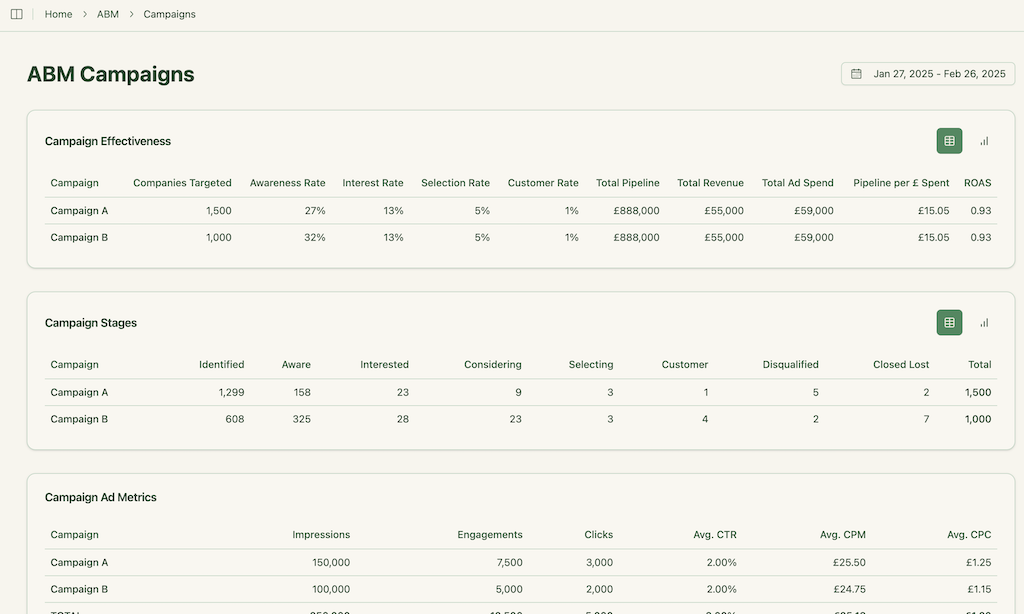
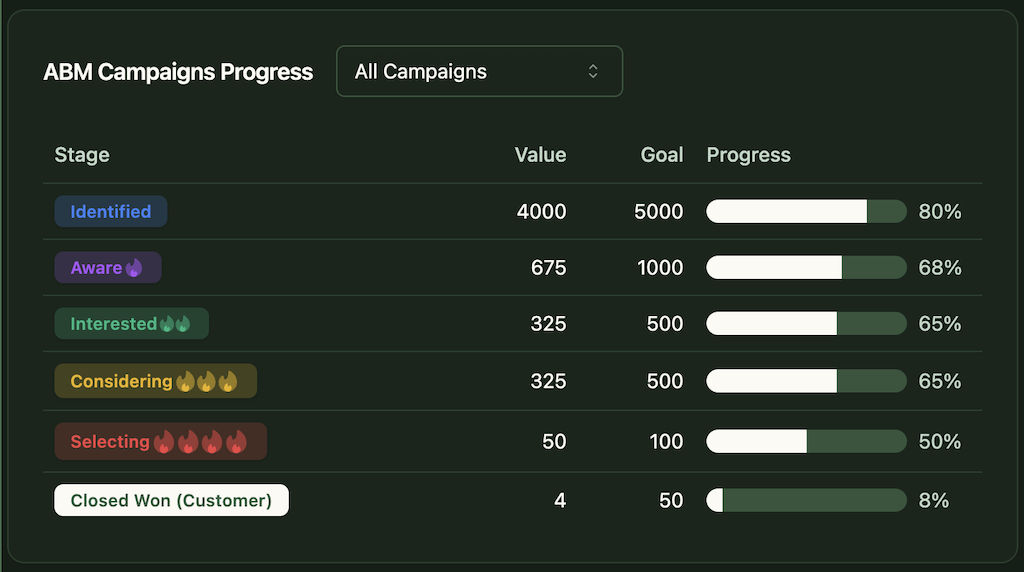
ROI & Attribution
Before I discuss the ‘how to’, let me show you Userpilot’s first campaign results:
- Accounts Touched: 1,417
- Total Spend: ≈$52.2K (LinkedIn + tools)
- Pipeline: $440K in 3 months
- Pipeline per $: $8.43 ($12 avg across both campaigns)
- Assets: ~100 ads across 8 personas
- Image Ads: 1,172 clicks (0.35% CTR, $19 CPC)
- Video Ads: 313 clicks (0.28% CTR, $24 CPC)
- Team: 4.5 FTEs (ABM manager, performance manager, MoP ops, head of marketing, etc.)
They also found ABM produced pipeline 2× faster and 51% cheaper than pure outbound.
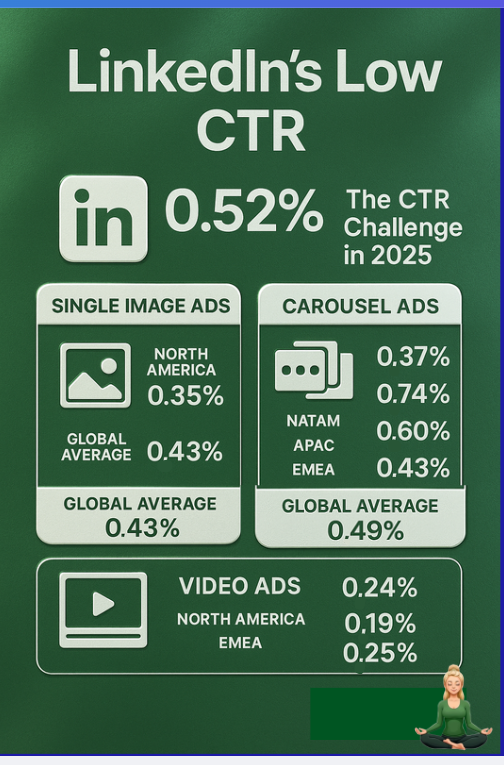
Now Their Attribution Method
Userpilot integrated HubSpot with company-level campaign data via ZenABM.
ZenABM, first, pulled company-level engagement data per campaign from LinkedIn’s official ads API:

Then It pushed the same data as company properties into the HubSpot account lists periodically:
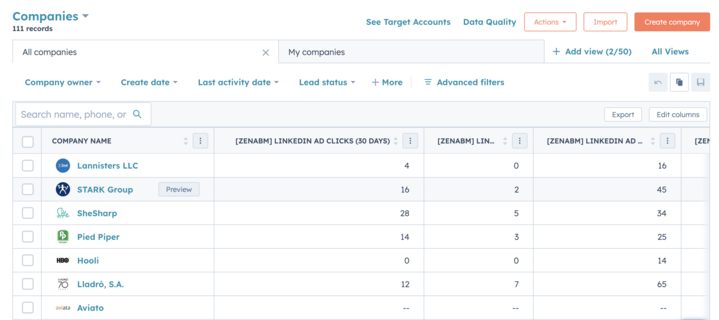
Plus, the tool also matched companies engaging with ads with the deals in CRM to map the impact of LinkedIn ads on pipeline and revenue:

Note: Even better attribution views are on the way at ZenABM.
Continuous Improvement
Double down on top performers, collect qualitative sales feedback, and repeat the loop. I meam, ABM is never “done.”
ABM Marketing Strategy Tool-Stack
| Requirement | Tool(s) | Purpose |
|---|---|---|
| CRM & Automation | HubSpot CRM + Marketing Hub | Centralize touches and align teams. |
| Sales Outreach | SalesLoft · Apollo | Automated cadences for engaged accounts. |
| List Building & Signals | Clay · BuiltWith APIs | Domain enrichment & tech-stack triggers. |
| Project Management | Notion | Track assets, deadlines, and launch plans. |
| ABM Analytics & Intent | ZenABM |
|
Final Thoughts
That’s your tactical blueprint for a high-impact ABM marketing strategy. For more details, reach out to me (the content guy at ZenABM) or Emilia Korczynska (VP of Marketing at Userpilot).
Plus, try ZenABM free today!

